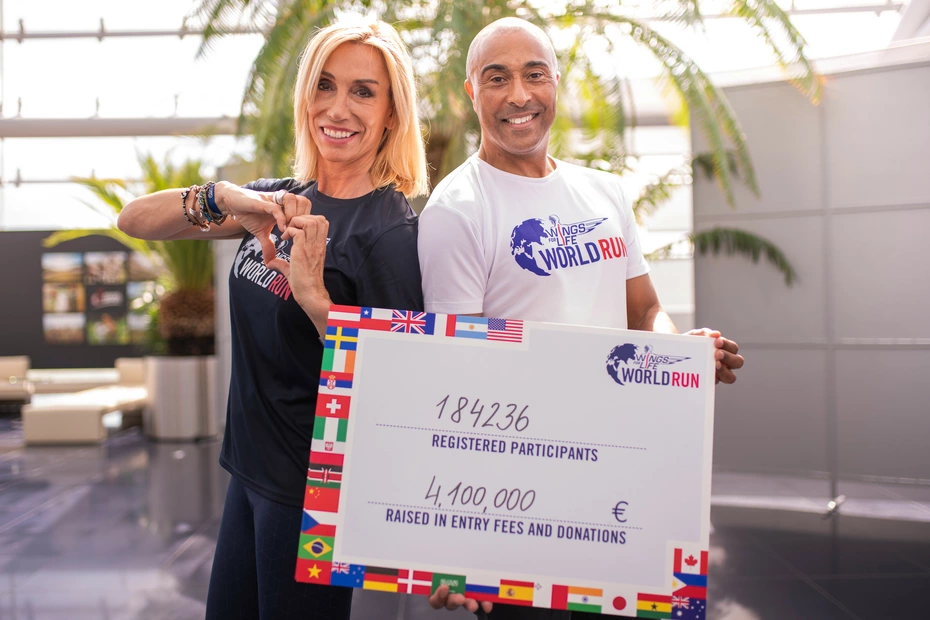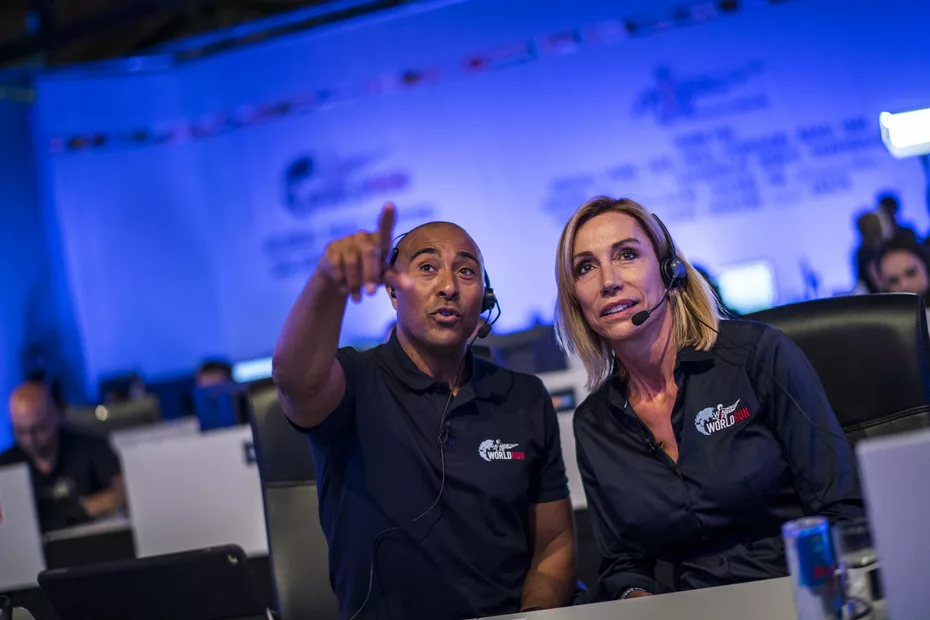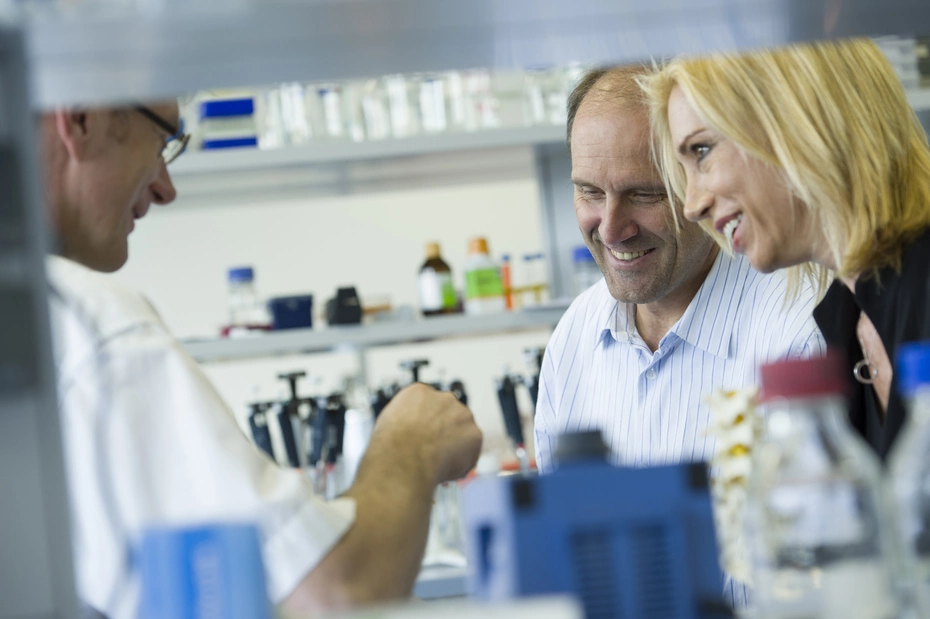Anyone who took part in the Wings for Life World Run 2021 will still have very vivid memories of the day. Not only because of the many records broken around the globe on May 9, 2021, it's also the atmosphere and lingering goosebumps that make this event so special for all participants. It's best to say the Wings for Life World Run has a lasting effect – even for Anita Gerhardter. During this interview, the CEO of Wings for Life spoke about major targets, hope, and a very special personal moment.
Anita, what feelings do your memories of the Wings for Life World Run 2021 still evoke in you today?
We work all year towards this one crucial day. To then see that so many people supported us and participated despite all the restrictions still makes me immensely happy and grateful. The extent of support was overwhelming.
"I wish to see many smiling faces defying the odds and spreading hope around the world in 2022."
– Anita Gerhardter

Anita Gerhardter and Colin Jackson presenting the donations raised in 2021.
What was your personal highlight from the App Run in 2021?
It is next to impossible to select a single one from the day's many highlights. However, if I had to choose a moment, it would be the feeling of happiness I had when Race Control told me the number of participants worldwide. Unforgettable. You have to understand: the Wings for Life World Run is our research funding pot's main source of income. When you hear that in just one day, 184,236 participants around the world ran for the good cause and raised millions in donations, you can't help but be overjoyed. In the end, donations totaled 4.1 million euros. And at this point, I would like to say once again to all who have contributed: thank you!
With the record year of 2021 now behind us: what are you expecting from the Wings for Life World Run 2022?
I would like to see us continue to grow. Our big goal is to get one million runners taking part by 2025. Keeping this goal in mind, I hope to take another big step in this direction in 2022. The more people participating in the Wings for Life World Run, the greater the progress in spinal cord research.
How do you go one better than the record year of 2021?
In the best case, our movement becomes increasingly self-sufficient. In 2021, we saw what it could look like when people all over the world independently run together with the app for the same goal. If everyone who ran last year encourages another family member or friend to join in 2022, that's exactly what happens. That's what I'm hoping for.
"The Flagship Runs have their own unique magic."
– Anita Gerhardter

Anita Gerhardter and Colin Jackson in Global Race Control, 2018.
What does the return of the Flagship Runs mean to you – why are they important to the spirit of this global charity event?
Many love to share the atmosphere and energy that prevails on this day – and in the company of like-minded people. The Flagship Runs make that possible. At the same time, they have their own unique magic. People are so mindful of each other there, and that's quite unique. I keep saying that ‘love is in the air’ – a truly contagious and fundamentally uplifting mood.
However, as important as the Flagship Runs are for their spirit and spillover of magic, for example, with the impressive TV images we've seen in recent years – the bottom line is that one thing counts more than anything else: running for a good cause! Who runs where, with whom, and for how long is beside the point. Whether it's an App Run or a Flagship Run, 100% of the Wings for Life World Run proceeds go directly toward research.
Talking of research: are there any updates on projects supported by Wings for Life?
When we set out in 2004 to find a cure for spinal cord injury, there were only basic and preclinical research projects and no promising clinical projects in sight. Seventeen years later, Wings for Life has helped to bring six projects into the clinic. And that alone is a massive success.

Wings for Life founders Heinz Kinigadner and Anita Gerhardter in conversation with scientists.
Which research project do you remember most?
One research project that I would now like to pick out as an example is a project for newly injured people led by Professor Marios Papadopoulos in London. He uses a method to measure the pressure in the spinal cord. By way of explanation: The brain and the spinal cord form the central nervous system, the CNS. When patients are hospitalized with a traumatic brain injury, the first thing is to measure the pressure in the brain. If it's too high, the pressure is relieved so that fewer cells die. However, no one has investigated this in detail with the spinal cord yet!
Professor Marios Papadopoulos has now started this. He places mini probes on the spinal cord to measure pressures there, as is now commonplace with the brain. In the process, he concluded that removing parts of the vertebrae is not enough if the pressure is too high. You also have to incise the thick membrane surrounding the spinal cord, the dura mater, to create space for the swelling tissue to expand, thus preventing further damage to the spinal cord. The pilot clinical study in London has been successful, and the procedure will now be tested throughout Europe for the initial treatment of newly injured patients. This could ensure that the extent of the individual injury is directly and sustainably limited in the crucial early hours from the outset.
"The more people participating in the Wings for Life World Run, the greater the progress in spinal cord research."
– Anita Gerhardter
What is your personal goal for the 2022 run?
My goal is to exercise even more consistently and regularly, with the hope that my running performance at the Wings for Life World Run will reflect this. I'm cautious with concrete goals and prefer to aim low and then overshoot (laughs). Let me put it this way: I'm not a runner, but I'd like to manage 10 km in 2022.
Not yet registered for the Wings for Life World Run on May 8, 2022? Join us HERE!
